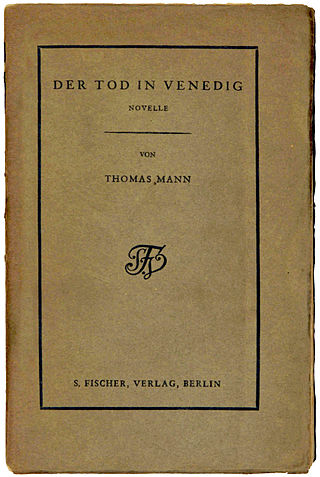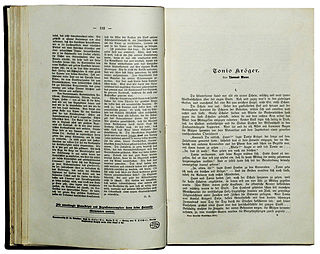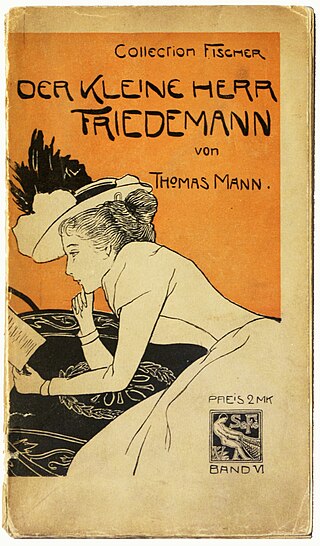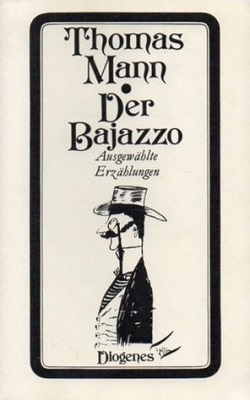
Cycling, also known as bicycling or biking, is the activity of riding a bicycle or other type of cycle. It encompasses the use of human-powered vehicles such as balance bikes, unicycles, tricycles, and quadricycles. Cycling is practised around the world for purposes including transport, recreation, exercise, and competitive sport.

Paul Thomas Mann was a German novelist, short story writer, social critic, philanthropist, essayist, and the 1929 Nobel Prize in Literature laureate. His highly symbolic and ironic epic novels and novellas are noted for their insight into the psychology of the artist and the intellectual. His analysis and critique of the European and German soul used modernized versions of German and Biblical stories, as well as the ideas of Johann Wolfgang von Goethe, Friedrich Nietzsche, and Arthur Schopenhauer.

"Long Distance Call" is episode 58 of the American television anthology series The Twilight Zone. It originally aired on March 31, 1961, on CBS. In the episode, a 5-year-old boy named Billy communicates with his dead grandmother using a toy telephone that she gave him on his birthday. It was one of the six episodes of the second season which was shot on videotape in a short-lived experiment aimed to cut costs.

Death in Venice (German: Der Tod in Venedig) is a novella by German author Thomas Mann, published in 1912. It presents an ennobled writer who visits Venice and is liberated, uplifted, and then increasingly obsessed by the sight of a boy in a family of Polish tourists—Tadzio, a nickname for Tadeusz. Tadzio was likely based on a boy named Władzio whom Mann had observed during his 1911 visit to the city.

A bike path or a cycle path is a bikeway separated from motorized traffic and dedicated to cycling or shared with pedestrians or other non-motorized users. In the US a bike path sometimes encompasses shared use paths, "multi-use path", or "Class III bikeway" is a paved path that has been designated for use by cyclists outside the right of way of a public road. It may or may not have a center divider or stripe to prevent head-on collisions. In the UK, a shared-use footway or multi-use path is for use by both cyclists and pedestrians.

Matthew 5:25 is the twenty-fifth verse of the fifth chapter of the Gospel of Matthew in the New Testament and is part of the Sermon on the Mount. In this first of the 6 Antitheses Jesus has been attacking anger and advocating reconciliation. In this verse he states that it is prudential to quickly reach agreement with one's adversary.

Tom Ritchey is an American bicycle frame builder, Category 1 racer, fabricator, designer, and founder of Ritchey Design. Ritchey is a US pioneer in modern frame building and the first production mountain bike builder/manufacturer in the history of the sport. He is an innovator of bicycle components that have been used in winning some of the biggest cycling competitions in the world including the UCI World Championships, the Tour de France and the Olympics. In 1988, Ritchey was inducted into the inaugural Mountain Bike Hall of Fame in Crested Butte, Colorado : and 2012, inducted to the United States Bicycle Hall of Fame in Davis, California.

Tonio Kröger is a novella by Thomas Mann, written early in 1901, when he was 25. It was first published in 1903. A. A. Knopf in New York published the first American edition in 1936, translated by Helen Tracy Lowe-Porter.

The Marvin Braude Bike Trail is a 22-mile (35 km) paved bicycle path that runs mostly along the shoreline of Santa Monica Bay in Los Angeles County, California. The coastal bike trail is widely acknowledged as Los Angeles' "most popular bike path."

Helen Tracy Lowe-Porter was an American translator and writer, best known for translating almost all of the works of Thomas Mann for their first publication in English.

Leave It to Beaver is a 1997 American comedy film directed by Andy Cadiff, based on the 1957–1963 television series of the same name. Many in-jokes and sub-plots relating to the series are adapted for the film. It features many of the original regular characters, most played by new actors, with some cameos by the original TV cast. The film was released by Universal Pictures on August 22, 1997.

"Little Herr Friedemann" is a short story by Thomas Mann. It initially appeared in 1896 in Die neue Rundschau, and later appeared in 1898 in an anthology of Mann's short stories entitled collectively as Der kleine Herr Friedemann.

"The Clown" is a short story by the 19th- and 20th-century German author Thomas Mann. It was first published in the German literary magazine Neue Rundschau in 1897, and were after his death, published as part of the collection Little Herr Freiedemann and Death in Venice and Other Stories.

"The Bicycle Thief" is the second episode of the American family sitcom television series Modern Family. It originally aired on ABC in the United States on September 30, 2009. The episode was written by Bill Wrubel and directed by Jason Winer.

The Los Angeles River bicycle path is a Class I bicycle and pedestrian path in the Greater Los Angeles area running from north to east along the Los Angeles River through Griffith Park in an area known as the Glendale Narrows. The 7.4 mile section of bikeway through the Glendale Narrows is known as the Elysian Valley Bicycle & Pedestrian Path. The bike path also runs from the city of Vernon to Long Beach, California. This section is referred to as LARIO, or more formally, the Los Angeles River Bikeway.

Cycling infrastructure is all infrastructure cyclists are allowed to use. Bikeways include bike paths, bike lanes, cycle tracks, rail trails and, where permitted, sidewalks. Roads used by motorists are also cycling infrastructure, except where cyclists are barred such as many freeways/motorways. It includes amenities such as bike racks for parking, shelters, service centers and specialized traffic signs and signals. The more cycling infrastructure, the more people get about by bicycle.

Władysław Gerard Jan Nepomuk Marya Moes was a Polish landowner and has been claimed as the inspiration for the character Tadzio in Thomas Mann’s novella Death in Venice, which was filmed as Death in Venice by Luchino Visconti.
The history of cycling infrastructure starts from shortly after the bike boom of the 1880s when the first short stretches of dedicated bicycle infrastructure were built, through to the rise of the automobile from the mid-20th century onwards and the concomitant decline of cycling as a means of transport, to cycling's comeback from the 1970s onwards.
David Luke (1921–2005) was a scholar of German literature at Christ Church, Oxford.

The Expo Bike Path is a 12-mile-long (19 km) rail with trail bicycle path and pedestrian route in Los Angeles County, California that travels roughly parallel to the Los Angeles Metro Rail's E Line between La Cienega/Jefferson and 17th Street/SMC stations. The Expo Bike Path is one of two major bicycle routes in Los Angeles that share dedicated rights-of-way with public transport, the other being the G Line Bikeway in the San Fernando Valley.


















